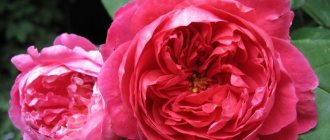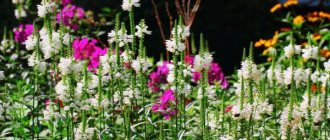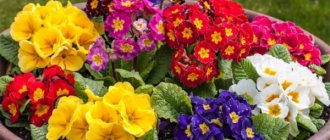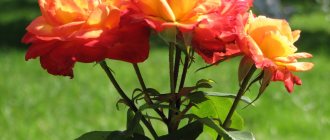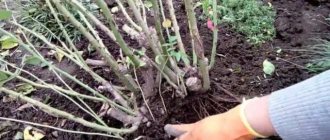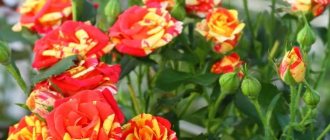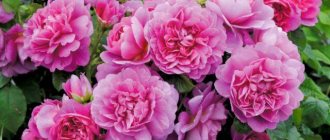The miniature rose appeared in Europe from China back in the nineteenth century. This plant immediately became popular and was then called tea rose. A short time later, the Indian rose appeared in Switzerland, and since then the selection of species has begun.
Author of the article
Maxim Sverchkov
Professional biologist and breeder with extensive experience and experience.
To date, they form a separate group, which includes about 5,000 varieties.
Dwarf roses - what is this group of garden flowers?
Small roses are a type of lush flowers that originated in China. Local breeders, after many years of hard work, were able to develop ornamental plants, which soon gained popularity in Europe.
Small roses are ideal flowers for decorating a garden and apartment
All types of miniature roses are similar in bush size, but differ in the structure, shape and shade of the petals. In addition, the following features of small roses can be distinguished:
- The buds can be one or two colors.
- A distinctive feature of dwarf varieties is that the stems grow only upward, creating a lush bush.
- As they ripen, the petals may change color.
- Flowers are usually collected in clusters of 5-20 buds.
- With proper care, domestic species can bloom all year round.
Interesting information! The ancestor of all low-growing varieties of roses is the variety Rouletii.
These plants can be grown in almost any form - standard, trellis, climbing and, depending on the variety, can be either perennial or annual. Due to this, they are used in different ways in landscape design. Flowers are grown in pots and flower beds. They are used to create borders and alpine slides. All you need to do is choose the type of mini rose you like.
History, features, advantages of small species
The birthplace of spray roses is Ancient China. Small varieties suitable for growing indoors were also bred there. They were brought to Europe at the beginning of the 19th century, but their selection began seriously only in 1918, when a miniature bush strewn with flowers was found by the Swiss Roulette.
The main feature is what a miniature rose bush looks like:
- height from 15 to 50 cm,
- dense foliage,
- abundance of buds,
- flower diameter no more than 2 cm,
- long flowering.
Botanists and simple gardeners are engaged in breeding the species, and both are successful. The number of varieties has long exceeded 150, and this is only in the “dwarf” subspecies.
The list of advantages of dwarf bush roses includes a wide color palette, no less than that of classic species, small but fragrant buds, dense foliage of a juicy dark green hue. Some varieties are characterized by a change in the color of buds and foliage as the bush ages, and several (up to 3 per season) waves of flowering.
Dwarf roses were participants in experiments in space - in 2002, with the help of the “Night Aroma” variety bush, the influence of gravity on the development and aroma of plants was studied.
The best varieties of miniature roses for growing in open ground and at home
David Austin roses - the most popular varieties
Among all the diversity of this variety, the most striking representatives stand out:
- Jewel. A bush variety with rounded leaves, bright red petals and a yellow center. Blooms from early summer to mid-autumn. A cut branch can stand for almost two weeks.
- Clementine. Ground cover hybrid with double buds. The ripe bud has a tangerine hue and a subtle citrus aroma. Has high immunity to various diseases.
- Cinderella. The white buds become soft pink over time. If you properly care for the plant, it can bloom several times per season.
- Hummingbird. Dwarf garden rose with small semi-double buds. Blooms from June to September. If grown in the southern regions, it can survive the winter without shelter. In the apartment it grows in flowerpots or pots.
- Lavender. Medium-sized bush with purple buds. Flowers grow on branches singly or in clusters of 3-5 pieces.
- Daniela. Compact miniature bushes with one distinctive feature – cup-shaped buds with pointed ends. They have high frost resistance, but weak resistance to fungal diseases.
- Gold Symphony. Small roses with some of the largest buds among dwarf varieties. The petals may be golden yellow or yellow-orange in color.
- Thumb Boy. A fairly young variety, bred in 2008. It got its name because of the structure of the bush - there is very little greenery on the branches, so the buds are located on almost bare shoots that resemble fingers.
- Amulet. Small pink roses are distinguished by the unusual appearance of their buds - when they bloom, they look more like chrysanthemums.
The amulet is classified not only among dwarfs, but also among floribundas and even scrubs
Rules for care and cultivation
Shrub roses have simple requirements for soil, light intensity, humidity, regardless of where they grow - in the garden or in a room, in a pot, whether they are perennial, young, or old enough. Basic conditions for their active growth and flowering:
- moderate humidity,
- no drafts,
- weak soil acidity,
- timely feeding,
- removing weeds.
Roses do not like dense soil; they prefer loamy soil. The minimum distance between plants is 30 cm. Both in pots and in holes when growing in the garden there must be drainage. When choosing a place to plant or place flowerpots in a room, you should immediately exclude the northern sides. In addition, you need to take into account that morning dew should not accumulate on the foliage (it should dry quickly), and if possible, minimize direct precipitation on the bush.
Top dressing
Outdoor and indoor rose plantings are fed at least three times during the active growth season. The first feeding is carried out immediately after the plant emerges from the dormant period. The source of nutrients is rotted manure, preferably horse manure. Indoor roses can be fed with special industrial compounds.
How to feed roses so that they bloom magnificently, read the article
During the flowering period, the bushes are treated with insecticides, fed with calcium nitrate (no more than 1 tablespoon per 10 liters of water), phosphorus, nitrogen, and wood ash. In autumn, the rose needs potassium, calcium, phytoncides, vitamins and other substances that can support it. Autumn fertilizing is carried out no more than once a month; ready-made formulations or infusions, decoctions are used as a source of nutrients
- ash,
- onion peels,
- eggshell,
- compost,
- bird droppings,
- manure
It is impossible to apply fertilizers of different types (organic or mineral) at the same time. The time period cannot be shorter than 10 days. The optimal frequency of feeding roses is 2 weeks.
Soil moisture
Watering is a very important point in growing flowers such as dwarf bush roses. Sudden temperature changes should not be allowed. The water temperature should be the same as the air temperature or be as close as possible to it. Compliance with this requirement will eliminate the risk of developing diseases in which flowering activity decreases and foliage falls.
Roses should be watered as needed. The soil should not dry out, but it should not be too wet either. The rate of development of bushes in a wetland decreases sharply, and buds may not form at all. In autumn and winter, if the rose overwinters in an apartment or house, the amount of watering is reduced.
It is important to understand that feeding with nutritional compounds diluted in water and watering are two different things. Fertilizing is carried out the next day after moistening the soil, after loosening the soil.
Trimming
This is another essential part of caring for a miniature bush rose. Pruning is performed in the spring, after the bush emerges from its dormant period. It consists of assessing the general condition of the plant and removing dead, diseased branches. The shoot is cut at an angle, immediately above the upper healthy bud. A branch that can be left must have at least 4 well-developed buds.
Mini roses in the garden - planting and care in open ground
Types of roses and popular varieties - what are they?
It is best to plant dwarf flowers in open ground in the fall. At the same time, it is recommended to purchase seedlings. To plant them, you must choose a well-lit place, protected from winds and drafts.
Important! You should not plant bushes where groundwater passes too close to the surface of the earth.
Planting should be done in slightly acidic, fertile substrates. Before this, the seedling itself must be placed in water for several hours. After this, planting is performed in a step-by-step sequence:
- A hole is dug slightly larger than the size of the roots. The soil is mixed with compost.
- The rose is placed in a hole and sprinkled with soil.
- It is recommended to leave at least a meter between seedlings.
When planting in clay soil, it must be mixed with sand.
How to grow small roses at home
Small roses are flowers that can be grown at home in pots. It is important to remember that they do not tolerate cold water and coolness in the summer. The purchased plant must be given time to acclimatize, and then it must be replanted. With the onset of warm nights, the pot with the plant can be taken out to the balcony.
Additional Information! After planting, the flower should first be kept in the shade, and then gradually moved to a lighted place.
Plant care
Self-rooted roses - what are they, varieties
Caring for mini roses is easy. They need to be watered regularly and the soil loosened after each moistening. It doesn't hurt to spray the plant. You need to feed the bush four times a season - in early spring, late spring, mid-summer and early autumn.
To give the bush its shape, it requires spring pruning. In autumn, only weak and dried branches need to be removed. A dwarf rose should be replanted only in the most extreme cases, when the pot becomes too small. After this, it should be left for a week in a dark place, and then transferred to the light.
Many varieties of dwarfs in warm regions survive the winter without problems. However, some of them should be prepared. To do this, remove all the leaves from them and cover them with insulation or film. At the same time, you must not forget to regularly open the bushes for ventilation.
Rose blossom
In open ground, roses bloom from early summer until autumn. At home, you can achieve flowering throughout the year. Throughout this time, they must be regularly fed with complex fertilizers. With the onset of the dormant period, the pot with the bush must be moved to a cool place.
In some cases, a dwarf rose may not bloom. This is usually due to the small size of the pot, lack of lighting and nutrients in the soil.
For the appearance of bright and lush buds, roses need proper care during the dormant and flowering periods.
Advantages and disadvantages
Every year more and more varieties of miniature roses appear. To obtain them, breeders cross low-growing crops with different varieties of roses. They have advantages and disadvantages. Let's talk about them in detail.
Advantages
Dwarfs have a number of advantages:
- reach 5-30 cm in height;
- they do not spread over the surface, concentrating on one area;
- the crop is densely leafy, has a crown consisting of many small leaves;
- flowers are painted in different colors: from red to purple;
- flowers can be admired for a long time.
Among the advantages can also be called terry.
Flaws
We can name only one minus among the many positive aspects. It lies in the fact that plants will not bloom profusely if properly cared for.
Diseases and pests
With proper care, most rose varieties are resistant to diseases and pests. However, sometimes powdery mildew, spider mites or aphids may appear on dwarf flowers. Regular treatment with fungicides and insecticides will help get rid of problems.
Small roses are flowers that are perfect for creating a bright background in the garden or decorating your home. They are easy to care for and delight owners for a long time with small buds of different shades.
